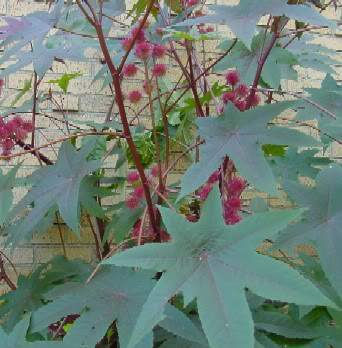Fun Facts
Here are a bunch of fun facts in case you just didn't get enough from the other pages!
Some odds and ends of the castor bean!
The leaves are large, palmately
lobed, have 8 points, are slightly serrated and have very large
central veins. The
seeds are contained in prickly or smooth three membered
capsules, also known as the fruit.
Each capsule contains their own seed.
 Seed
size is known to be between 450 to 5,000 seeds per pound.
In the commercial industry they are more commonly 1,000
to 1,500 seeds per pound.
Seed color varies from plant to plant and can be white,
gray, yellow, brown, red or black.
The seed itself also has a pattern on it that can be
brown, black or gray and they can be splotchy or fine spots.
Each seed contains between 40% and 60% oil that has
triglycerides, specifically ricinolein.
Seed
size is known to be between 450 to 5,000 seeds per pound.
In the commercial industry they are more commonly 1,000
to 1,500 seeds per pound.
Seed color varies from plant to plant and can be white,
gray, yellow, brown, red or black.
The seed itself also has a pattern on it that can be
brown, black or gray and they can be splotchy or fine spots.
Each seed contains between 40% and 60% oil that has
triglycerides, specifically ricinolein.  The colors of the leaves can be green or a brownish red.
The flowers are typically green but other varieties have
different colors such as red and pink.
The plant’s stamens tend to stay near the bottom and the
pistils (female reproductive part of flower) near the top.
There are no petals on the plant and the female flower,
which lie above the male flowers, consist of a little spiny
ovary which develops into the fruit or seed capsule.
Interested in learning about a flower that has petals?
Learn about the rose
here.
The colors of the leaves can be green or a brownish red.
The flowers are typically green but other varieties have
different colors such as red and pink.
The plant’s stamens tend to stay near the bottom and the
pistils (female reproductive part of flower) near the top.
There are no petals on the plant and the female flower,
which lie above the male flowers, consist of a little spiny
ovary which develops into the fruit or seed capsule.
Interested in learning about a flower that has petals?
Learn about the rose
here.
The castor bean also includes a deadly toxin called ricin.
When ricin enters the body it
prevents the cells from producing the proteins they need.
Without these specific proteins the cells cannot function and
they die. If this cell death
is wide spread enough it can lead to the organism dying.

Between November of 1969 and January of 1970 about 10,000 ducks
died in Texas. Autopsies of
the ducks revealed castor beans in their stomachs.
The castor oil plant has been known to contribute to large
numbers of casualties annually.
During the 1940’s the U.S. military experimented with ricin testing
for the possibility for use as a warfare agent.
However, there were never any reported cases of the military
using it as a weapon. Ricin
was used as a weapon in the 1980’s in Iraq and more recently by
terrorist organizations!
But don't worry if you know someone who has been poisoned by ricin. Ricin poisoning isn’t contagious therefore it cannot be spread by
casual contact.
 In 1978 a Bulgarian writer named Georgi Markov was attacked by a
man with an umbrella. The
umbrella had been modified to inject a ricin pellet under the
journalists skin. He died
three days later from the poison!
In 1978 a Bulgarian writer named Georgi Markov was attacked by a
man with an umbrella. The
umbrella had been modified to inject a ricin pellet under the
journalists skin. He died
three days later from the poison!
Want to know the sources used? Then head to the References section!
Back to Home To Multipleorganisms.net To UW-Lacrosse
